Norwegian Lefse (Made In A Frying Pan)
Guess what? You don’t need a lefse iron or a special rolling pin to make delicious homemade lefse at home. This recipe is a great starter recipe for traditional Norwegian recipe-loving cooks.
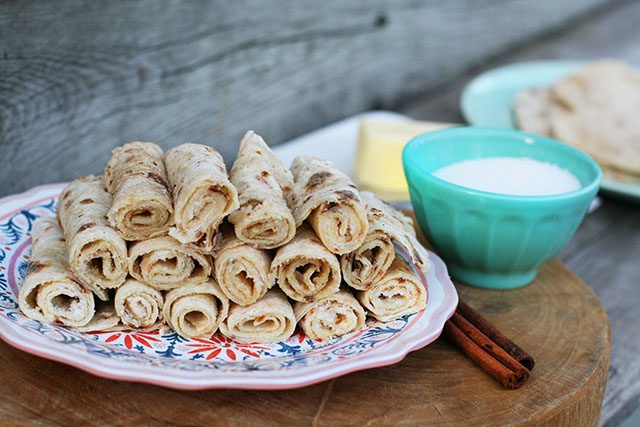
Do you hear that?
That’s the sound of a thousand Norwegian grandmothers gasping at the thought of making lefse any other way than the traditional way: That is, using a potato ricer to mash the potatoes, special rolling pin to roll out the dough, and a lefse iron to cook it on.
Well, I’m here to tell you that it’s okay to make lefse the non-traditional way.
Why?
Because if you’re only going to make lefse once or twice, then it’s probably not worth it to buy the special rolling pin and lefse iron.
Do you really need more stuff in your kitchen?
However, if lefse making is an annual family tradition – something you’ll make very often – then by all means, buy all the special equipment you want!
Just remember: You can make some darn good lefse without proper lefse-making equipment! Take it from me: I’m 98% Norwegian according to Ancestry.com.
This recipe results in some delectable, melt-in-your-mouth lefse. Eat it fresh while it’s still warm, or reheat for a few seconds in the microwave. Store in the fridge, or in an airtight container in the freezer to keep it fresh.
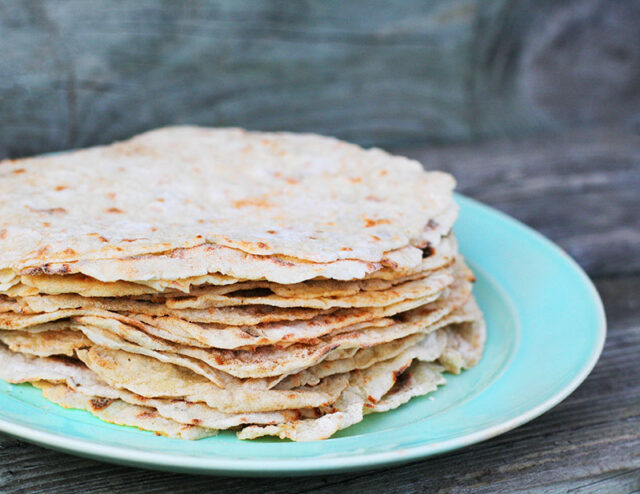
What Is Lefse?
Lefse is a traditional Norwegian potato-based flatbread. In the U.S., among the Norwegian-American population, it is served spread with butter and sprinkled with sugar. However, there are many other creative ways to eat it:
- Spread with butter, topped with cinnamon and sugar
- Spread with butter and marmalade
- Used as a wrap for a sandwich
- Used as a “bun” for a hot dog
Lefse is made much like homemade tortillas. If you can make tortillas, you can make lefse!
How To Prepare Lefse
My family eats lefse every Thanksgiving and Christmas. At Christmas, we always it serve it with oyster stew.
We don’t always make it homemade – sometimes we buy it at the grocery store.
Our preferred lefse toppings are simple: spread on a generous layer of butter and sprinkle with sugar.
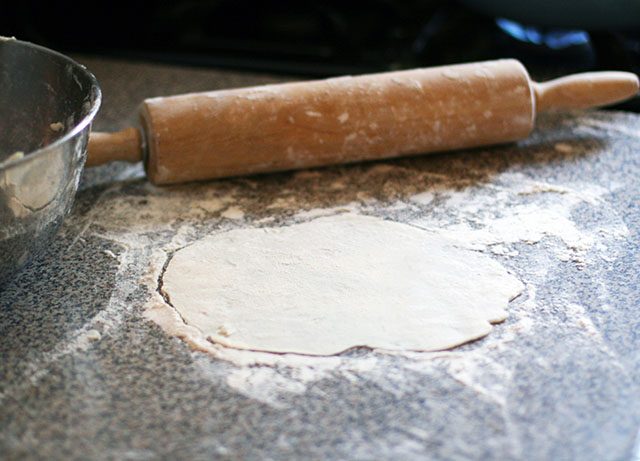
Lefse Making: The Process
This is the lefse-making process, in a nutshell. Scroll down for the detailed recipe.
- Make mashed potatoes with cream and butter
- Mix cooled mashed potatoes with flour
- Form into balls and roll into thin rounds
- Cook in a dry frying pan on each side
Making lefse in a frying pan isn’t difficult – just a bit time-consuming. But it’s totally worth it!
Can You Make Lefse With Instant Mashed Potatoes?
Although I always make lefse using fresh potatoes, many people swear by making lefse with dried instant potatoes.
I don’t want to dissuade you from making lefse with instant potatoes – it seems to work and be the preferred method by many tried-and-true lefse makers.
However, I never have success using instant potatoes.
If you make lefse with instant potatoes, feel free to share your methods or recommendations in the comments, below.
Can You Make Lefse On An Electric Griddle?
Yes, you can use an electric griddle to make lefse. The process is similar to making traditional lefse – or lefse in a frying pan. Roll out the lefse into a thin round, about the size of a tortilla. Carefully lift the dough and place it on the electric griddle set to 375F.
Get More Norwegian Recipes
I love exploring my Norwegian-American heritage by experimenting with traditional Norwegian recipes like these:
- Sweet soup (sot suppe)
- Norwegian almond cake
- Cranberry almond cake
- Rice pudding (risgrøt)
- Potato dumplings (potet klub)
- My Norwegian grandma’s meatball recipe (kjøttkaker)
- Swedish meatballs
- Lutefisk
- Open-faced sandwiches
- Flatbread (flatbrod)
- Rømmegrøt
- Rommegrot bars
- Almond kringler
- Kringla
- Goro
- Rosettes
- Krumkake
- Sugar cookies (sandbakkelse)
- Pepperkaker cookies (spiced sugar cookies)
- Norwegian egg coffee
- Non-alcoholic gløgg (mulled juice)
- Scandinavian snack board (great for entertaining)
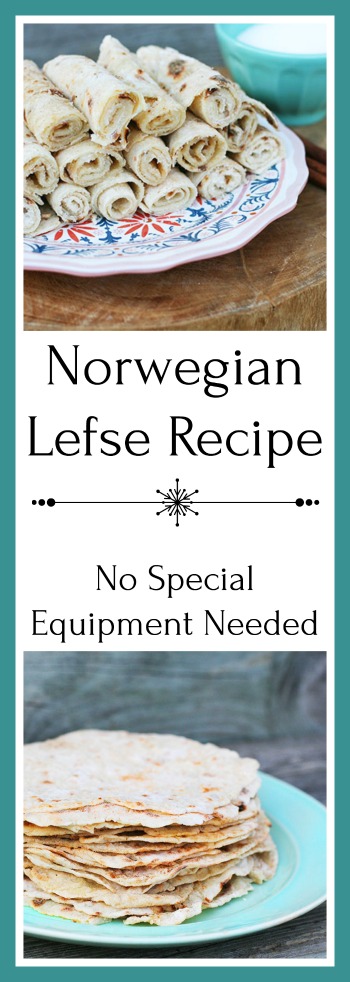
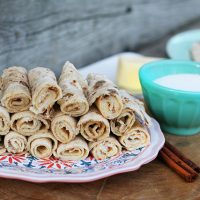
Norwegian Lefse
Roll out the lefse as thin as possible without tearing. Use plenty of flour to avoid sticking.
Ingredients
- 2 large or 3 small russet potatoes
- 1/2 cup heavy whipping cream
- 3 tablespoons butter
- 1 teaspoon salt
- 1 1/2 cups all purpose flour, plus extra for rolling out
Instructions
- Peel potatoes and cut into large chunks. Place in a large saucepan and fill with enough water to reach an inch from the top. Heat to a simmer, and allow to cook until potatoes are tender: About 20 to 25 minutes.
- Remove potatoes from heat, drain, and rinse with cold water. Add cream, butter, and salt. Mash until smooth or use a potato ricer.
- Measure out 3 cups of cool mashed potatoes. Mix with 1 cup of flour, and add 1/4 cup (or more) until the dough is pliable but not sticky. If the dough is too dry, add some more of the mashed potatoes. If it's too moist, add a bit more flour.
- Take a golf ball sized-piece of dough. On a floured surface, roll out the dough to make a thin round flat - like a tortilla. Roll the dough as thin as possible.
- Transfer to a dry frying pan. Cook the lefse over medium heat until it's a light golden brown - this will take about a minute. You'll notice a few bubbles in the lefse. Flip and cook on the other side for 30 to 45 seconds, until light golden brown. Transfer to a plate to cool.
- Continue with this process until all the lefse has been cooked. Eat right away, store in the fridge for up to 3 days, or freeze for future use.

I simply love lefse and I like trying new ways of cooking ESPECIALLY when they are easier methods. Thanks for sharing!!
Yes, me too! I’m all about easy recipes 🙂
You can use just a regular rolling pin? Do I need to try to cover it, like with a sock?Also, when using a fry pan you say to heat on medium. I have watched videos that say to heat a griddle to 500 degrees. Won’t I need to set my stove on high to get it hot enough? I am excited to try to make lefse without buying special equipment!
Hi Brenda! I always use a regular rolling pin. I’m not sure what you mean by covering it? Once you’re done making the lefse, if you let it sit on the counter it will dry out so I either cover it or put it in the fridge in an airtight container.
For frying the lefse… honestly it takes a little trial and error. My first 3 or so pieces don’t turn out great, but after that the pan is nicely coated and I’ve figured out exactly how hot the frying pan needs to be (a solid medium). Good luck!
Thanks, Haley!
Love your addition of heavy cream…that’s how I remember
my mom and gram making it. Also, your suggestion for
just using a skillet instead of sweating it, trying to find a
ginormous griddle! 👍👍😍
Ah, yes, that’s how we’ve always made it! (With cream).
And glad you approve of the frying pan/griddle method!
What did you use to flip your lefse?
Just a fork! It’s small enough in the frying pan and thick enough for this to be possible.
Haley, thanks for your wonderful recipe. I lost my mom’s recipe, and yours is the closest by far to hers.
Wonderful! So glad this was an acceptable substitute 🙂
Hi Haley! As a fellow Norwegian I have wanted to try making my own for soooo many years!!! I have always “settled”for my grandmas or the hometown bakery’s version which were just “ok”! I even tried Maid of Scandinavia’s version this year and wasn’t impressed! You have given me the inspiration to try making my own ! I will let you know how it turns out!!
You must try it yourself, Elaine! It’s a fun process, and nothing beats fresh lefse. Let me know how it goes, please 🙂
I’m gonna defend my investment in a lefse griddle here. I use it the way my grandmother did: for everything.
At least for breakfast. I use it constantly to make bacon, fried and scrambled eggs, pancakes, hamburgers, hotdogs, sausages, grilled cheese sandwiches. I’ve even used it to make Japanese dishes that require a flat metal surface like you see at ‘hibachi’ steakhouses.
I’m curious how lefse used heavy cream is going to come out. I’ve always used what is probable a lazy recipe that I got from my parents, using instant potatoes. It takes a deft hand to turn the lefse after cooking the first side because it tears easier than what I remember my grandmother’s recipe doing. (I never helped her mix it, but I helped her cook it.)
Eric…. A half cup of whipping cream does not add much weight distributed over a batch of 20 Lefse. Instant potatoes may be quick but using cooked Russet potatoes is the way to go.
Enjoy
Making or at least eating lefse has been a holiday staple for my chilhood with my grandmother. Now my daughter makes it with me and she is great at rolling it thin and not tearing. Harder to buy in the SW USA and better homemade.
I grate the Russet Potatoes and then rice them. I have used both Heavy cream and Buttermilk but I prefer the Buttermilk. If you like the taste of Buttermilk Pancakes you will understand. My Mother and Father used to make Lefse on a wood burning stove in the kitchen. Mother would roll and my dad would flip them. I just watched and waited to eat the first piece with butter, sugar and cinnamon. Yum !
I usually buy lefse. But years ago I ask my Grandfather how he made it. He came from Norway around 1908 and among his many trades had owned a bakery.
He surprised me when he recommended potatoes flakes. We don’t make lefse often but it always turns out well.
Making lefse is a New Year’s Eve tradition in my family. We have been doing it for something like 60 years. We had a lefse griddle that for the longest time was used for only lefse. I think it was made from a cast aluminum frying pan that had the sides flatten out so it had just the slightest rise. It was great. My sister and I are starting to make our favorite Norwegian-American recipes on our own while my mother is still around to “test” our results and see if we are doing it right. We have been doing them under her guidance for a long time, but now we are trying them completely on our own. She says so far we are doing fine! I have tried using instant mashed potatoes – they work for small batches if they are eaten right away, but they do NOT store well. I have tried making them with sweet potatoes and that works VERY well. It limits its uses a bit, but tastes wonderful! (if you like sweet potatoes).